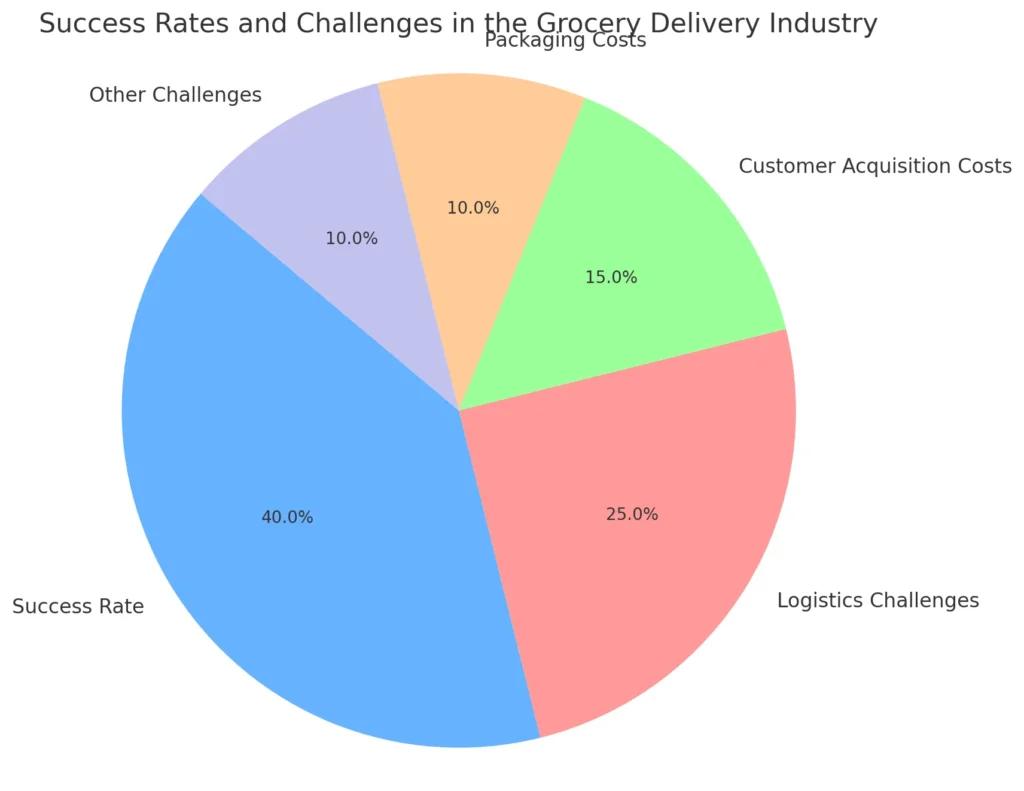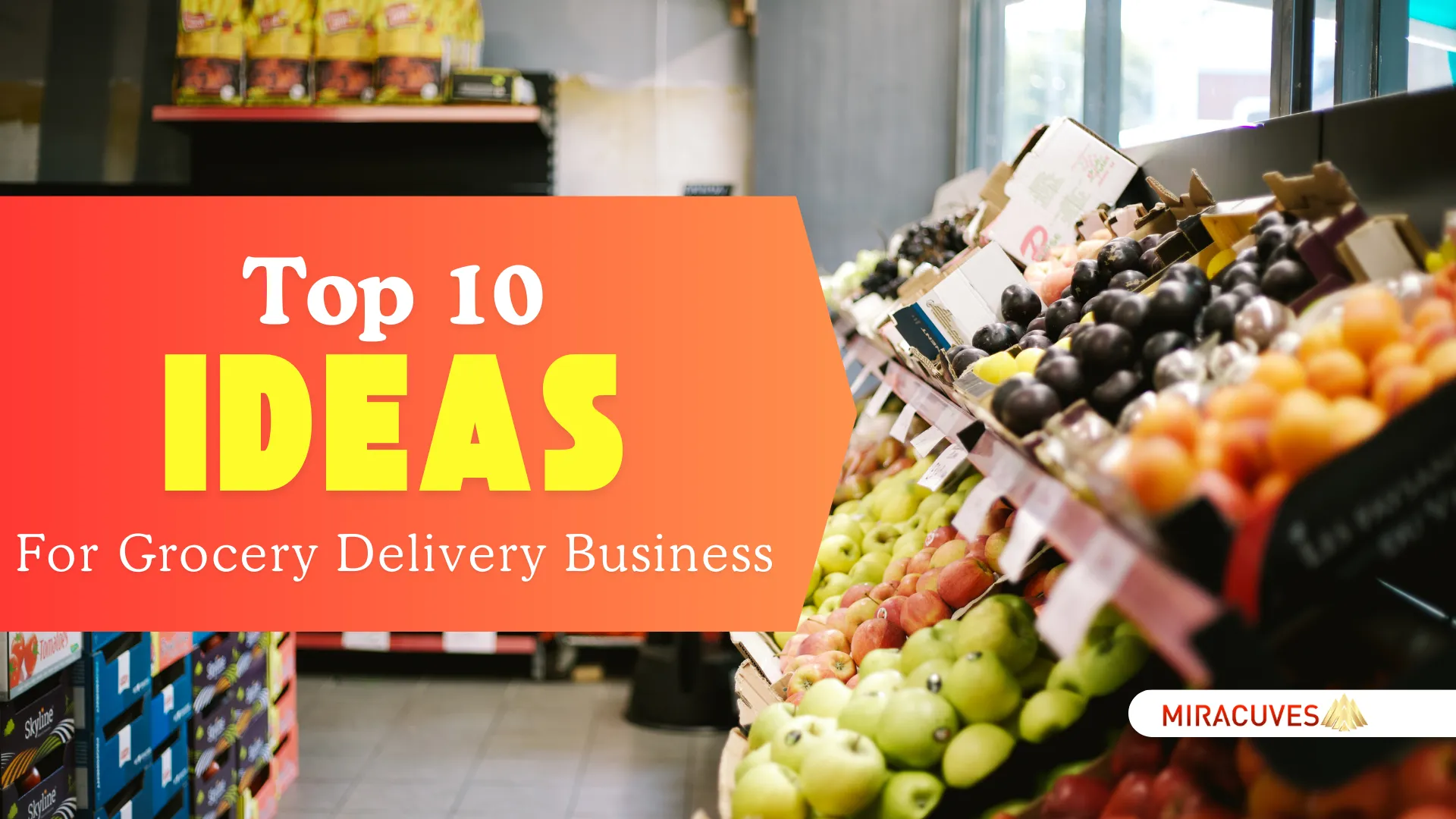In today’s fast-paced world, the grocery delivery industry is thriving, driven by a growing demand for convenience and time-saving solutions. Consumers increasingly prefer having fresh groceries delivered to their doorsteps, making this sector one of the fastest-growing in e-commerce. The COVID-19 pandemic accelerated this trend, shifting grocery shopping habits toward online platforms and contactless deliveries, and it has continued to expand ever since.
For aspiring entrepreneurs, the grocery delivery business offers numerous opportunities for innovation and profitability. From subscription-based meal kits to ultra-fast delivery services, there are endless ways to make a mark in this space. Whether you’re looking to create a hyper-local delivery service or a specialized organic produce platform, the grocery delivery industry offers a promising and versatile market for new startups.
Why Choose the Grocery Delivery Industry?
El grocery delivery industry is booming, capturing the attention of both consumers and investors. In an era where convenience is king, the demand for fast, reliable grocery delivery services has skyrocketed. Busy lifestyles, urbanization, and the rise of digital platforms have shifted grocery shopping preferences toward online ordering and doorstep delivery. This trend is further driven by advancements in technology, which enable quick and seamless shopping experiences, as well as an increased focus on health and wellness, with more people seeking fresh, organic, and specialty products.
For entrepreneurs, the grocery delivery industry presents a unique blend of high consumer demand and growth potential. By tapping into niche markets—such as eco-friendly packaging, rapid delivery times, or curated local produce—businesses can differentiate themselves and cater to specific customer needs. The scalability of this industry also allows for various business models, from hyper-local deliveries to national services with extensive supply chains.
Current Trends and Future Opportunities in Grocery Delivery
| Tendencia/Tecnología | Descripción | Impacto en la industria |
|---|---|---|
| Quick Commerce | Ultra-fast delivery within 10-15 minutes | Increased customer satisfaction in urban areas |
| Embalaje ecológico | Sustainable, reusable packaging solutions | Atrae a consumidores con conciencia ecológica |
| Specialized Dietary Options | Focus on organic, vegan, gluten-free products | Appeals to health-focused customers |
| AI and Data Analytics | Optimization of routes and personalized suggestions | Efficiency and better customer experience |
The grocery delivery industry is evolving rapidly, with innovative technologies and shifting consumer preferences shaping its future. One of the biggest trends today is quick commerce or ultra-fast delivery, which aims to fulfill grocery orders in as little as 10-15 minutes. This trend is driven by the demand for immediate convenience, especially in urban areas where speed and efficiency are top priorities. Major players are investing heavily in micro-fulfillment centers and AI-driven logistics to make this service possible, signaling a significant growth area for startups.
Another growing trend is the focus on sustainability and eco-conscious packaging. Consumers increasingly prefer businesses that minimize plastic use and prioritize environmentally-friendly practices. Startups that adopt sustainable packaging or offer reusable containers for deliveries are attracting eco-conscious customers and aligning with a global shift toward greener practices.
Specialized grocery services are also gaining traction. These services cater to specific dietary needs or preferences, such as organic produce, gluten-free options, or plant-based products. By tapping into niche markets, businesses can attract loyal customers looking for specific products.
Looking forward, there’s enormous potential in integrating artificial intelligence and data analytics. These tools can help businesses optimize routes, reduce delivery times, and offer personalized recommendations to enhance the customer experience.
Top 10 Ideas for Grocery Delivery Business Startups
The grocery delivery space offers numerous pathways for startups to enter and thrive, each with unique approaches to capture specific customer needs. Here are ten innovative ideas that can help new businesses make an impact in this high-demand industry.
| Idea | Approximate Startup Cost | Mercado objetivo | Potencial de ganancias |
|---|---|---|---|
| Hyper-Local Grocery Delivery | Moderado | Local communities | Moderado a alto |
| Subscription-Based Meal Kits | Alto | Busy individuals | Alto |
| On-Demand Organic Produce | Moderado a alto | Consumidores preocupados por la salud | Alto |
| Ethnic and Specialty Foods | Moderado | Cultural and ethnic food shoppers | Moderado |
| Zero-Waste Grocery Delivery | Moderado a alto | Clientes con conciencia ecológica | Alto |
| Fast Grocery Delivery (Quick Commerce) | Alto | Urban areas | Alto |
| Seniors and Assisted Living | Bajo a moderado | Elderly and mobility-challenged | Moderado |
| Bulk and Wholesale Delivery | Moderado | Families and small businesses | Moderado |
| Health and Wellness Delivery | Moderado a alto | Fitness and health-focused consumers | Alto |
| Grocery Delivery with Nutrition Tracking | Alto | Fitness and diet-conscious | Alto |
1. Hyper-Local Grocery Delivery
Focusing on local markets with a fast, community-centered delivery service, prioritizing fresh, local products and shorter delivery times.
- Mercado objetivo: Local shoppers seeking fresh, fast delivery
- Requisitos de inicio: Partnerships with local vendors, quick delivery logistics
- Estimated Startup Cost: $5,000 – $15,000 (delivery infrastructure, marketing)
2. Subscription-Based Meal Kits
Offering curated meal kits with pre-measured ingredients, ideal for busy individuals seeking convenience without compromising on quality.
- Mercado objetivo: Busy individuals, families looking for convenient meal prep
- Requisitos de inicio: Recipe curation, ingredient sourcing, packaging
- Estimated Startup Cost: $10,000 – $30,000 (ingredient procurement, packaging, marketing)
3. On-Demand Organic Produce Delivery
A service focused on delivering organic fruits, vegetables, and other products, catering to health-focused customers.
- Mercado objetivo: Health-conscious consumers seeking organic produce
- Requisitos de inicio: Partnerships with organic farms, delivery network
- Estimated Startup Cost: $8,000 – $20,000 (organic supplier partnerships, delivery logistics)
4. Ethnic and Specialty Foods Delivery
Targeting customers interested in international or culturally specific foods not easily available in mainstream stores.
- Mercado objetivo: Food enthusiasts, culturally diverse customers
- Requisitos de inicio: Sourcing specialty ingredients, cultural cuisine knowledge
- Estimated Startup Cost: $6,000 – $18,000 (sourcing, import costs, cultural marketing)
5. Zero-Waste Grocery Delivery
A sustainable model that delivers groceries with minimal or zero plastic, using reusable containers or compostable packaging.
- Mercado objetivo: Environmentally conscious shoppers
- Requisitos de inicio: Sustainable packaging, partnerships with eco-friendly suppliers
- Estimated Startup Cost: $8,000 – $25,000 (eco-friendly packaging, reusable containers)
6. Fast Grocery Delivery Service (Quick Commerce)
Providing ultra-fast delivery within 10-15 minutes, perfect for urgent needs, requiring efficient logistics and strategically placed fulfillment hubs.
- Mercado objetivo: Urban customers needing quick service
- Requisitos de inicio: Well-placed hubs, optimized delivery routes
- Estimated Startup Cost: $20,000 – $50,000 (logistics infrastructure, fulfillment hubs)
7. Grocery Delivery for Seniors and Assisted Living
Catering to elderly customers and those with mobility issues, providing easy ordering options and special assistance during delivery.
- Mercado objetivo: Seniors, people with mobility limitations
- Requisitos de inicio: User-friendly ordering platform, trained delivery staff
- Estimated Startup Cost: $5,000 – $15,000 (platform development, customer service training)
8. Bulk and Wholesale Grocery Delivery
Focusing on bulk purchases for large families or small businesses, appealing to cost-conscious customers with lower prices per unit.
- Mercado objetivo: Large families, small business owners
- Requisitos de inicio: Sourcing bulk items, efficient inventory management
- Estimated Startup Cost: $10,000 – $30,000 (inventory management, bulk purchasing)
9. Health and Wellness Grocery Delivery
Providing products tailored for specific dietary needs like gluten-free, keto, or vegan options, perfect for health-focused consumers.
- Mercado objetivo: Health-conscious shoppers, people with dietary restrictions
- Requisitos de inicio: Specialized product sourcing, dietary expertise
- Estimated Startup Cost: $8,000 – $20,000 (specialized inventory, dietary labeling)
10. Grocery Delivery with In-App Nutrition Tracking
A delivery service with integrated nutrition tracking to help customers monitor their daily intake, appealing to fitness enthusiasts.
- Mercado objetivo: Fitness enthusiasts, diet-conscious consumers
- Requisitos de inicio: App development, nutrition tracking integration
- Estimated Startup Cost: $15,000 – $40,000 (app development, data integration)
Ejemplos del mundo real
As the grocery delivery industry continues to grow, many startups have paved the way with innovative approaches, overcoming challenges and finding success. These real-world examples showcase diverse business models, highlighting what works and inspiring new entrepreneurs to carve out their own paths in this competitive field.

One success story is a company that specialized in hyper-local delivery within specific neighborhoods, delivering fresh, locally-sourced produce within an hour. This approach attracted health-conscious customers who valued the freshness and low environmental impact of locally-sourced goods. By focusing on a smaller geographic area, this startup minimized delivery times and built a loyal community of repeat customers.
Another standout is a zero-waste grocery delivery service that caters to eco-conscious consumers. This company introduced reusable packaging options, allowing customers to return containers for a discount on their next order. Not only did this model reduce plastic waste, but it also built a strong brand identity around sustainability, a key factor driving its growth.
Finally, an example of a subscription-based meal kit service demonstrates the power of convenience in modern grocery delivery. Offering tailored meal kits with easy-to-follow recipes, this startup attracted busy individuals looking to eat well without spending time on grocery shopping. The subscription model provided a steady revenue stream and allowed the company to offer exclusive meal options to subscribers.
Mistakes to Avoid When Starting a Grocery Delivery Business
| Error común | Descripción | Medida preventiva |
|---|---|---|
| Underestimating Logistics | Inefficient delivery systems lead to delays | Invest in route planning and reliable transportation |
| Lack of Target Market Identification | Trying to serve all audiences | Define a specific audience for focused service |
| Ignorar los comentarios de los clientes | Missed opportunity to improve service | Implement feedback loops, like surveys |
| Overlooking Sustainable Practices | Missing appeal to eco-conscious customers | Use eco-friendly packaging and efficient routing |
Starting a grocery delivery business can be highly rewarding, but it’s essential to navigate common pitfalls to build a sustainable and successful operation. Avoiding these mistakes from the outset can save valuable time, money, and resources while helping establish a strong foundation in a competitive market.
Un error común es underestimating logistics. Efficient delivery is the backbone of a grocery service, and overlooking the importance of logistics can lead to delays, increased costs, and dissatisfied customers. It’s crucial to invest in route planning, reliable transportation, and a well-organized delivery schedule to maintain a smooth operation.
Another pitfall is failing to identify a target market. Many new businesses aim to cater to everyone but end up spreading resources too thin. Defining a specific target audience—whether it’s health-conscious consumers, busy urban dwellers, or budget-focused shoppers—enables a focused marketing approach and tailored service offerings.
Ignoring customer feedback can also hinder growth. Listening to customer feedback is a powerful way to improve service quality, identify pain points, and build loyalty. Establishing open lines of communication, such as easy-to-access support or post-delivery surveys, can provide insights that fuel business improvements.
Finalmente, overlooking sustainable practices can be a misstep, as more consumers today prefer environmentally friendly options. Integrating eco-friendly packaging, optimizing delivery routes to reduce fuel consumption, and offering reusable containers can attract a loyal base of eco-conscious customers.
¿Por qué confiar en Miracuves Solutions para su próximo proyecto?
Choosing the right partner for your grocery delivery business is critical to its success, and Miracuves Solutions stands out as a trusted provider in this space. With years of expertise in delivering customized app solutions, Miracuves Solutions understands the unique needs of grocery delivery startups, from seamless order management to advanced logistics and customer-friendly interfaces.
Miracuves Solutions emphasizes innovation and reliability. Our team brings together experienced developers, industry strategists, and design experts who work collaboratively to create user-friendly applications that keep customers engaged. With a focus on end-to-end support, we ensure each project is tailored to match your business goals and market requirements.
Our commitment to client success is demonstrated by our successful portfolio of projects. We prioritize transparency, efficiency, and post-launch support to help you navigate the grocery delivery landscape with confidence. When you partner with Miracuves Solutions, you gain access to technology that scales with your business and a team dedicated to your growth.
Conclusión
The grocery delivery industry is filled with exciting opportunities for entrepreneurs willing to innovate and meet the demands of today’s convenience-driven consumers. By understanding industry trends, targeting specific customer needs, and steering clear of common pitfalls, you can create a business that thrives in this competitive market. Whether it’s through quick delivery times, eco-friendly practices, or tailored meal kits, there are countless ways to stand out and capture loyal customers.
Starting a grocery delivery business involves careful planning, but with the right strategies, the journey from idea to launch can be both rewarding and profitable. With a focused approach and a commitment to quality, you can tap into a growing market and bring fresh, convenient solutions to people’s doorsteps.
Preguntas frecuentes
What are the basic requirements to start a grocery delivery business?
To start a grocery delivery business, you need a reliable supply chain, a user-friendly app or website, efficient logistics for delivery, and a target market. Additionally, securing permits and ensuring quality control is essential for building trust with customers.
How much capital is needed for a grocery delivery startup?
The capital required can vary based on your business model. A small, local delivery service may start with minimal investment, while a comprehensive app-based platform with a delivery fleet could require a more substantial amount. Planning your budget according to scale is crucial.
What is the best way to attract customers to my grocery delivery business?
Offering promotions, discounts for first-time users, and a seamless app experience are great starting points. Focus on high-demand products, reliable delivery times, and clear communication to establish a loyal customer base.
How can I ensure my grocery delivery business is environmentally friendly?
Use sustainable packaging, optimize delivery routes to reduce emissions, and consider reusable container options. Marketing these green practices can also attract eco-conscious customers who value sustainability.
What are the main challenges in the grocery delivery industry?
Key challenges include managing logistics efficiently, maintaining product freshness, handling customer service, and staying competitive with pricing. Planning and adapting to these challenges can help you maintain a stable and successful business.





























































